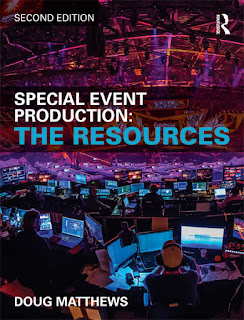My most popular post to date has been the one about determining horizontal stage size for an event. In this post, thanks to several questions, I address the vertical dimension.
The first assumption in determining the
height of a stage is that the special event is not being held in a venue with a
permanent stage such as a theater. Otherwise, the height is dependent on the
size of the audience, whether they will be sitting or standing, and whether the
ground or floor is level (we will assume in this section that the surface is
level). Standing audiences can occur for concerts, receptions, dances, trade
shows, product launches, and others. Seated audiences can occur at dining
events, award ceremonies, opening and closing ceremonies, meetings, and
numerous others. We will deal with each of these.
Standing Audience
In order to make an educated determination
of the correct height for a standing audience, we must make some assumptions of
human characteristic body dimensions and typical spacing between persons in a
standing crowd. For purposes of this exercise only, let us assume that the
average person is approximately 5 ft 11 in. (179 cm) tall and that in a
standing crowd, people will tend to space themselves no closer than 2 ft (0.6
m) apart. Also, we must assume that persons in the crowd are able to maneuver
themselves sufficiently to see over the heads of other persons two rows ahead
of them (i.e. about 4 ft, or 1.2 m in front of them). If we further assume that
at minimum any persons in the audience must see at least the top part of the
head of an average person standing on the stage (near the front or downstage
edge of the stage), then we can draw some sight lines to assist us with
calculating the correct stage height that will relate directly to the size of
the crowd. Figure 1 does just this. Note that at 25 ft (7.6 m) away from the
stage, a person is able to see the top part of the head of someone onstage if
the stage is 3 ft (1 m) in height. Likewise, at 50 ft (15 m) from the stage,
the height must be raised to 4 ft (1.2 m) to achieve similar visibility and at
100 ft (30 m) away from the stage, the height must be at least 8 ft (2.4 m) for
the same visibility. It is clear from this explanation that given a specific
audience size and venue size, that a stage should be constructed of sufficient
height to enable the entire audience to view the stage in the worst case
scenario. For example, even in the case of a standup reception at which there
will be stage entertainment, the assumption must be made that during the
entertainment, attendees will crowd the stage to the extent that they will be
about 2 ft apart, even though when the entertainment is not on, this may not be true.
Figure 1: Stage Height Determination for a Standing Audience
Seated Audience
For a seated audience, the height is also
determined by the ability to see over the head of a person sitting directly
across a table (if dining) or directly in front by two rows (if theater-style).
We will illustrate the principle by using a dining situation in which diners
are seated at 72 in. (1.8 m) diameter round tables, separated by 10 ft (3 m)
center-to-center. Exactly the same principle applies as for the standing
scenario, except that, because the distance from the observer to the person
opposite is much greater than the critical distance in a standing crowd, the
angle is lower and so the stage can be that much lower in height. Figure 2 illustrates the angles and can be used to calculate approximate stage heights.
Once again, the worst case scenario must be assumed and if the tables are less
than 72 inches in diameter (e.g. 60 in. or 1.5 m rounds) then the calculation
must be rechecked. Note also that because of the low angle, a constant stage
height may be used for the nearest 50 ft (15 m) to the stage before the stage
height really needs to be increased, unlike the standing situation.
Figure 2: Stage Height Determination for a Seated
Audience
It should be kept in mind that the
variables in determining stage height are many (e.g. slope of ground if
outdoors, proximity of audience members to each other, whether performers stay
on mainly the downstage portion of the stage), so the above analyses are only
intended to be general guidelines and not hard rules. Each situation will be
different and in some cases, a lower stage might be adequate.
Read more about this and many other topics in my new books.











